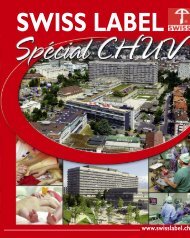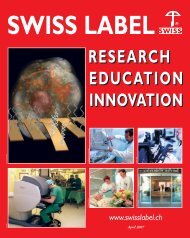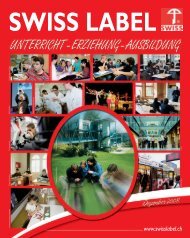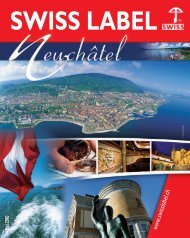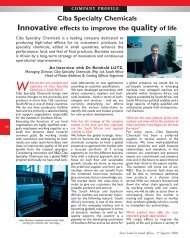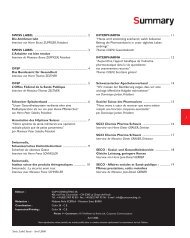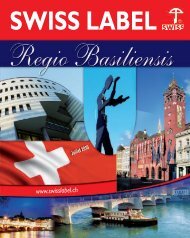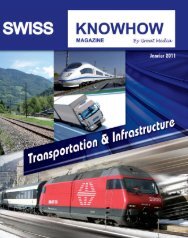swiss label - Com Consulting SA
swiss label - Com Consulting SA
swiss label - Com Consulting SA
Create successful ePaper yourself
Turn your PDF publications into a flip-book with our unique Google optimized e-Paper software.
At 14 years of age, the Università della Svizzera italiana (USI) is one of the youngest and most dynamic universities in<br />
Switzerland. While continuing to work on the quality of its teaching and research in its founding Faculties – Economics,<br />
Architecture and <strong>Com</strong>munication Sciences – more recently USI ventured out beyond the humanities and the social<br />
sciences, to reach the hard sciences: a new departure that opens up fresh opportunities in both research and education.<br />
Involvement in the hard sciences further reinforces one of USI’s most important characteristics: its international<br />
orientation.<br />
Professor Martinoli, the Faculty of Informatics was set up in 2004 and the<br />
Institute of <strong>Com</strong>putational Sciences in 2008: why opt for disciplines that<br />
are so different from the three existing Faculties?<br />
“In both cases USI has opted for original choices that are sustainable<br />
over time and have great potential both in terms of education and of<br />
scientific research. We also weighed up our opportunities and synergies<br />
with other research centres in the Italian-speaking part of Switzerland,<br />
to boost our critical mass at an international level."<br />
What have been the initial results of these choices?<br />
“Looking back over the past five years, I'm happy to say that with the<br />
decision to create the Faculty of Informatics we played a winning card.<br />
The number of registered students continues to increase and its success<br />
is evident above all from the point of view of the competitive research<br />
funds that the new Faculty has been able to attract to Lugano. We are<br />
now the third-largest centre for informatics in Switzerland after the<br />
two Swiss Federal Institutes of Technology. As to computational<br />
sciences, on the other hand, it is too early to draw any conclusions<br />
because the Master’s degree doesn’t start until next academic year. But<br />
I am very confident: the new institute offers us the possibility of<br />
addressing problems of great interest and complexity in a vast range of<br />
disciplines, and so to further enhance our reputation as an innovative<br />
and interdisciplinary university. Obviously, the presence in Ticino of<br />
the Swiss National Supercomputing Centre (CSCS), which is run by<br />
the Swiss Federal Institute of Technology in Zurich (ETHZ), has had<br />
a crucial influence on this choice. And it is precisely with the group<br />
of computational sciences of ETHZ, located on our Lugano Campus,<br />
that we shall develop beneficial synergies. But other research partners<br />
in our neighbourhood will also be involved in the activities of the new<br />
institute: the Department of Innovative Technologies at SUPSI and<br />
the Institute for Research in Biomedicine (IRB), soon to be affiliated<br />
to USI.”<br />
What is the potential for research in this new field?<br />
“It is huge: with the advent of the new generation of supercomputers,<br />
which operate as virtual laboratories in their own right, computational<br />
sciences help us to address, using modelling and numerical simulation,<br />
problems of great interest and complexity right across a broad spectrum<br />
of disciplines. A university such as ours could never have afforded the<br />
investment required to engage actively in the domain of experimental<br />
research, which these days is extremely expensive. But now, thanks to<br />
supercomputers and the expertise developed at the new institute, we will<br />
be able to engage immediately in numerous new areas of research.”<br />
For example?<br />
“There are countless applications, but if we are to make optimum use of<br />
them, we will need to put all our efforts into developing mathematical tools<br />
(algorithms) capable of fully exploiting the complex architecture of<br />
the new supercomputers. With these instruments we should be able to<br />
Swiss Label Ticino 2010<br />
C O M PA N Y P RO F I L E<br />
L’Università della Svizzera italiana<br />
address relevant problems in biology (enzyme reactions, drug design),<br />
bioengineering (implants), in materials science (designing materials with<br />
tailor-made properties), in fluid dynamics, meteorology and in<br />
finance (market analysis). In some cases, in addition to the potential<br />
of supercomputing, we will be able to exploit synergies with other<br />
research centres in the region.”<br />
Both degree curricula are in English: why?<br />
“This is a choice we had to make; having made it, we can now draw<br />
on a pool of students and researchers from a much wider catchment<br />
area than Canton Ticino or neighbouring Italy. We have adopted the<br />
same logic for most of our Master’s degree courses and the results have<br />
been excellent: so far more than 60% of our students have come from<br />
abroad, and they have chosen Lugano for the originality of its degree<br />
programmes. There is a fundamental consideration underlying our<br />
decision: USI has never been envisaged as a university only for the<br />
population of Ticino; it wouldn’t have made any sense. And without<br />
of course reneging on, or neglecting, strong bonds with our native<br />
region, our strategy has been to widen our horizons internationally,<br />
creating a broad range of opportunities also for our home students. To<br />
this end, the English language seemed an obvious and indispensable<br />
passe-partout.”<br />
Campus Lugano,<br />
Via Giuseppe Buffi 13, CH-6904 Lugano<br />
Campus Mendrisio,<br />
Largo Bernasconi 2, CH-6850 Mendrisio<br />
E-mail: press@usi.ch - Website: www.usi.ch<br />
© Università della Svizzera italiana<br />
23



